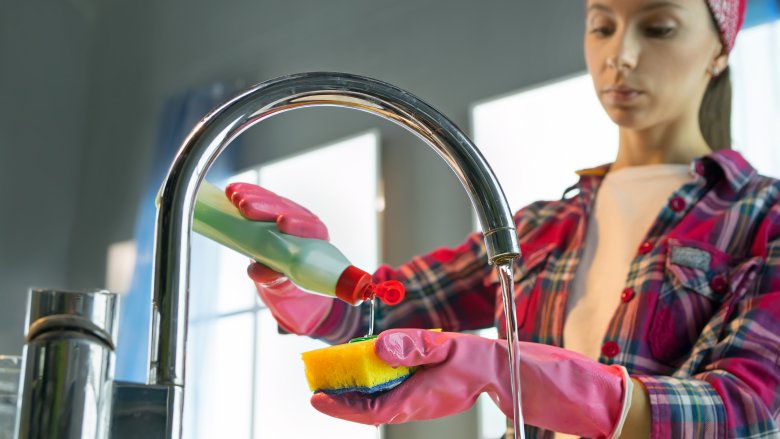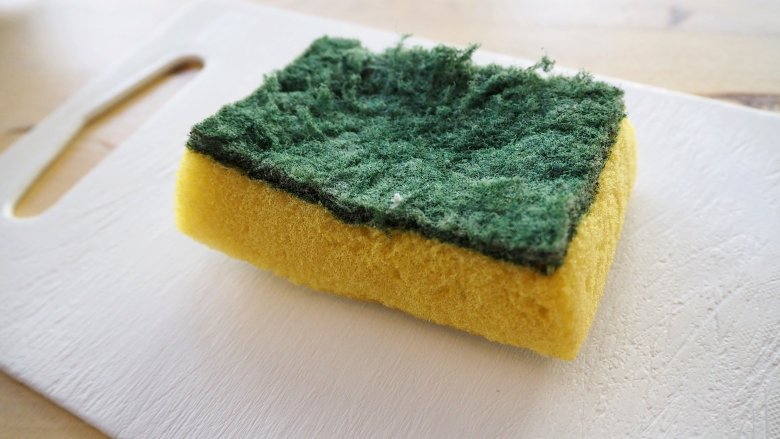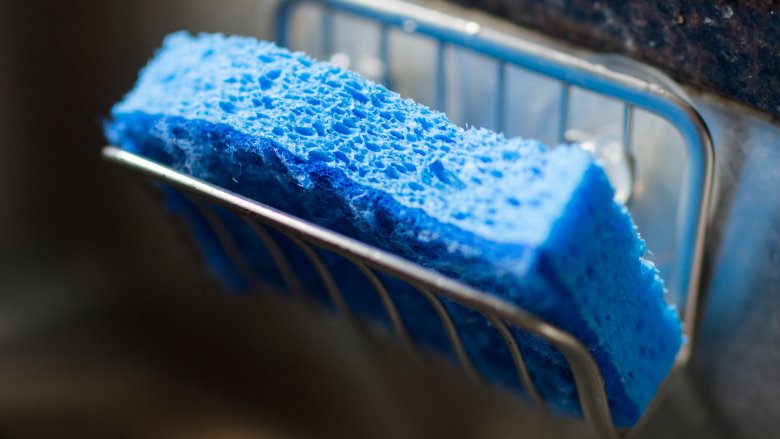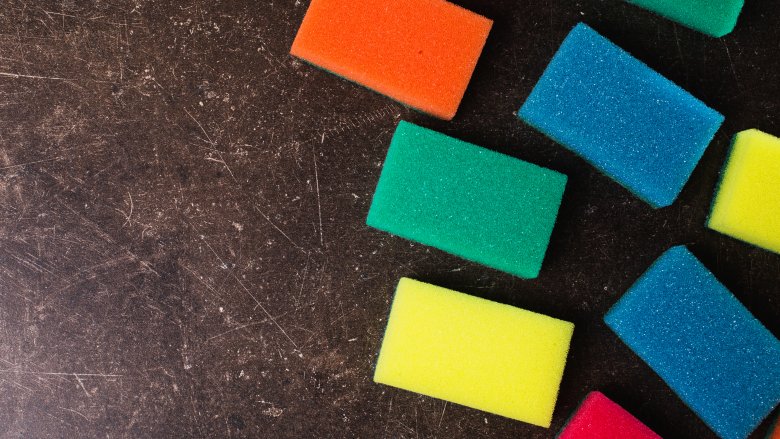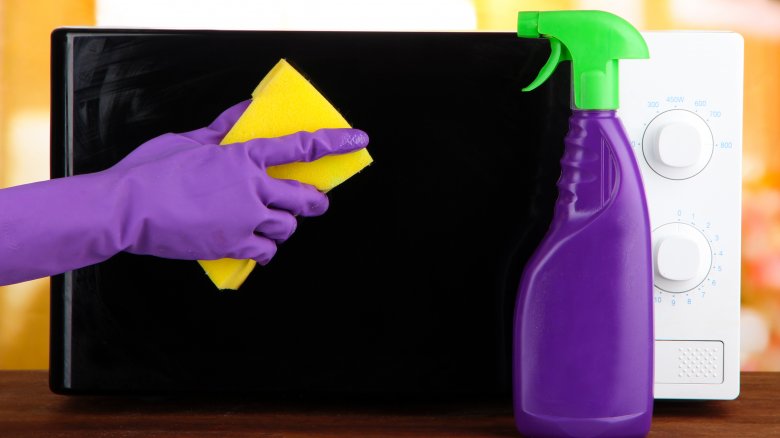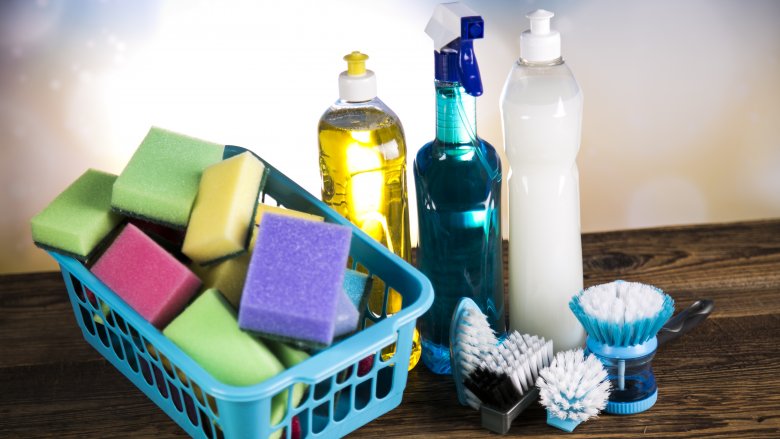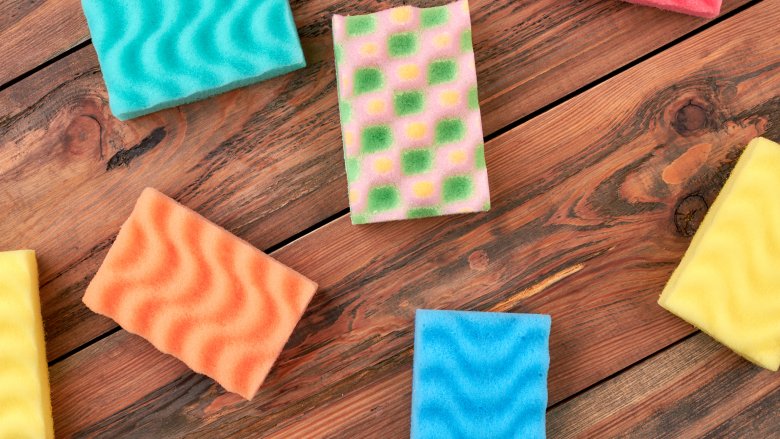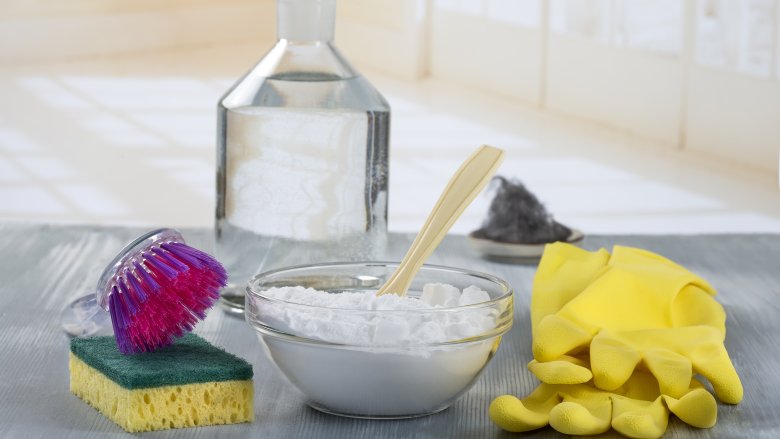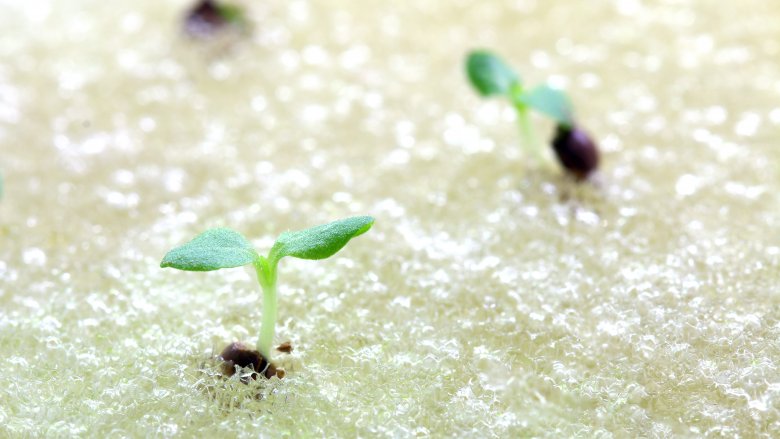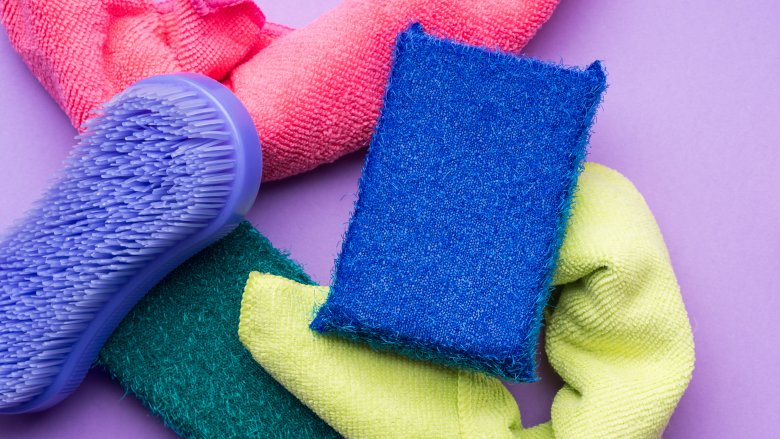You're Using Your Kitchen Sponge Totally Wrong
We all have more gadgets than we can count in the kitchen, and there's always plenty of maintenance and upkeep to be done. But there's a catch: you probably overlook one of your most frequently used kitchen tools: your sponge.
It's handy, it's versatile, it's always within reach... and when is the last time you really paid attention to it? You really should, because there's more going on in that one little kitchen sponge than you might expect. Sure, you've heard that it harbors germs, and even if you put it away in a sponge holder that lets it drain, you're not done yet. You shouldn't be, at least. Using and caring for your sponges the right way is going to go a long way in keeping your kitchen clean, your dishes bacteria-free, and your family healthy. See? It's a bigger deal than you thought, so let's talk kitchen sponges.
You're using it on food prep areas
We've all done it: we're working on a prep area near the sink, and need to wipe it down. You grab your sponge, rinse, wipe, rinse, and don't give it a second thought. But you absolutely shouldn't be using your dish sponge to wipe your counters down, and here's why.
Merry Maids says your food prep areas — especially cutting boards and butcher blocks used to prep raw meats — are breeding grounds for the same bacteria you're trying to keep out of your sponge and off your dishes. Hot water and soap aren't going to cut it, and swiping across your prep area with your sponge is introducing it to all kinds of nastiness. A better idea is to use disinfectant or bleach wipes on those areas, or paper towels with a disinfectant spray. That way, you can toss them right in the garbage and not worry about introducing more bacteria to a kitchen tool that's already the perfect damp environment for breeding all kinds of little microorganisms that have the potential to make your whole family sick.
You're not putting it away right
Researchers from the University of Furtwangen in Germany (via Reader's Digest) found that a single square inch of kitchen sponge material can harbor as many as 82 million bacteria, and that's hard to imagine. For comparison, they say that's about the same amount of bacteria that's in a similar-sized sample of poop... so remember that next time you're wondering whether or not it's time to replace that sponge.
In the meantime, you should at least be storing it properly after you use it. How? Merry Maids says you should be rinsing it thoroughly after each use, then wring it out as much as you can. The drier it is, the better, and you should also be storing it somewhere the air can circulate around it. Don't just leave it in the sink; that's going to make it even more bacteria-friendly.
You're not replacing it enough
First, a question: when is the last time you got a new kitchen sponge? If you can't answer right away, it's probably been too long.
According to The Cleaning Authority's VP of Operations Leanne Stapf (via Well+Good), how often you use your sponge dictates how often you should replace it. If you cook at home most nights, and wash all your dishes, pots, and pans with that sponge, you should get a new one every other week. If you're more the take-out, dining-out type, or if you have a dishwasher that does the heavy lifting, you should still replace it every month. If that seems like a waste, it's not. Even if you're not using it every night, it still gets damp and dirty, and it's still breeding bacteria — and no one wants to be smearing that all over their dishes, even if it's just used every few days.
You think microwaving makes it clean
You've probably heard that throwing your sponge in the microwave is great way to get rid of the bacteria that's growing there, and that's sort of right. According to The Cleaning Authority's VP of Operations Leanne Stapf (via Well+Good), you can definitely soak your sponge, wring it out completely, and nuke it to kill some of the bacteria. But, there's a catch.
In 2017, Scientific Reports published a study that looked at the little ecosystem you have growing in your kitchen sponge. (If that idea grosses you out, good! It's supposed to!) While every house, kitchen, and sponge is different, they found bacteria including salmonella and staphylococcus in the typical kitchen sponges they tested. When they microwaved the sponges and took another look, they found that while it did kill a large percentage of the bacteria living there, it didn't kill it all.
There's another problem, too. The bacteria that survived the microwave reproduced quickly, and it wasn't long before that bacteria had completely re-infested the sponge. While it might be a short-term solution, it's definitely not going to prolong your sponge's useful life by much.
You throw away the old one
Once your bacteria-filled kitchen sponge has outlived its usefulness in the sink, that's no reason to throw it away. Stash it under the sink or on the windowsill, then use it to clean up all the dirty places in the kitchen you and your family aren't going to be licking on a regular basis.
First, run it through the washing machine with bleach and hot water to get rid of as many of the germs as possible. Then use it to scrub out the garbage cans and recycle bins, to wipe down walls, and to get rid of those inevitable cobwebs. Use it in the bathroom, too, and in all those places that could use a good scrubbing.
It's probably looking pretty funky by this time, but just so no one gets it mixed up with a sponge you want to use anywhere else, cut the corner off. Then, you'll know it's your dirty-job sponge, and you'll get some extra mileage out of it. Every penny counts, after all, and it's a great way to recycle and reuse. With that one simple trick, it's also a guarantee you're not going to get your cleaning tools mixed up.
You're not keeping one in the freezer
Why would you keep a sponge in the freezer? A few reasons!
Take a new kitchen sponge, rinse, and wring out so it's damp. Put it in a plastic baggie and pop it in the freezer for a DIY ice pack. They're great for a few uses, so you might need to make a bunch. If you're packing lunches and need something cold that's light enough it's not going to crush your sandwich, use your frozen sponge ice pack. The icy sponge will keep your lunch cold, and once it thaws, the sponge will absorb the water and keep it from leaking. Brilliant!
They're also great for those inevitable kitchen injuries. When is the last time you touched a hot pan or bumped the side of the oven when you were taking something out? Grab one of these handy little guys out of the freezer, and you'll find they're perfect for taking the sting out of little injuries, from burns to bee stings. If you do use this life hack for emergencies, just remember to refresh your sponges every few weeks.
You're not using them in your fridge
When we say you should use your kitchen sponges in your fridge, we don't mean to wipe up spills and leaks. We mean you should replace your box of baking soda with this simple trick from This Old House.
Baking soda is a versatile deodorizer, and the old way of doing things is to put an entire box in the back of your fridge... then forget to change it, right? Instead, take a new kitchen sponge, rinse, and wring it out until it's only slightly damp. Sprinkle baking soda on the surface of the sponge, then clear a spot on the door for it. It'll help absorb any funky odors in your fridge, and since it's right there when you open the door, you wont forget about it. Refreshing it is easy, too — just rinse out the old and add some more baking soda. It's cheap, easy, and there will be no more slightly damp, sort of gross boxes of baking soda being forgotten about in the back of the fridge.
You're not using it as a garden
If you're only picking up a package of sponges with the idea that you're going to use them just for cleaning, you're missing out. They're also a perfect medium for sprouting seeds, and that makes them great for starting an herb garden on your windowsill — no matter how little space you have.
All you need to do is rinse a new sponge, and wring it out so it's damp but not dripping. Put it on a solid surface, and "plant" your seeds in the cracks and crevices of the sponge. Keep it moist and in the sun, and you should see sprouts in a matter of days. SF Gate recommends using fast-growing seeds, and if you're planning on keeping your little garden on your sponge, that's stuff like watercress and alfalfa.
You can absolutely use this method for your own little windowsill garden (whether you use the herbs or just use it for a neat decoration), and you can sprout seeds for transplanting outside or into a bigger garden this way, too. Pretty cool, right?
You're still using traditional kitchen sponges
Kitchen sponges probably aren't something you spend much time thinking about, but next time you're at the store picking up a fresh pack, you should rethink your choices. If you're still going for those old-school yellow sponges with the green scrub pad, you might want to try something else — there are a ton of options out there.
Business Insider looked at some of the new sponge technology that's available, and yes, there is such a thing. Their favorite was the Scrub Daddy, a funky, sun-shaped sponge that firms up in cold water (for tough jobs) and softens in warm or hot water for reaching nooks and crannies.
There's also a ton of microfiber sponges out there, and these will dry fast and won't smell as funky as standard sponges. Another good option is investing in some silicone sponges. They feel like your favorite silicone bakeware, they're easier to keep clean, more sanitary, and longer-lasting. It's time to give your old sponges the boot.
